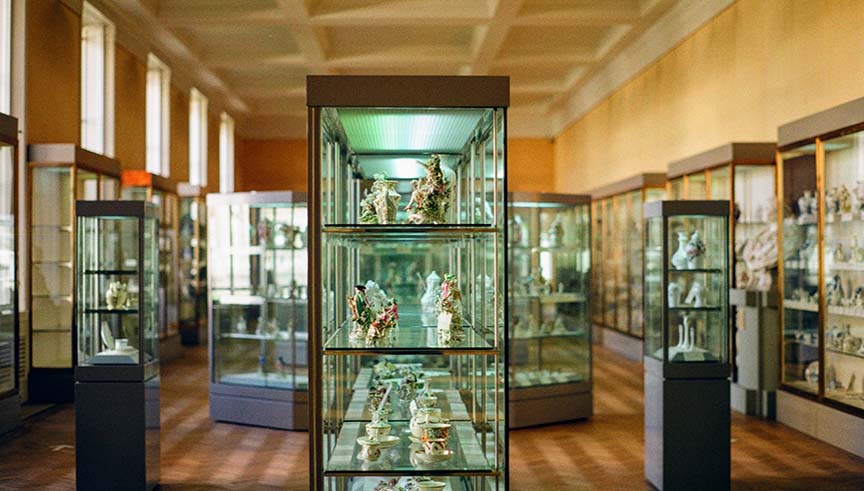
Cambridge’s Art and History: Must-Visit Museums
My recent visit to Cambridge, UK, was an enlightening journey through the city’s cultural heritage. Renowned for its prestigious university and charming landscapes, Cambridge also boasts a wealth of world-class museums and galleries, housing a diverse range of art and historical treasures. I will share my first-hand experiences and insights into three personal favorites and introduce four more exceptional artworks and exhibits that should be on every visitor’s itinerary.
1. The Fitzwilliam Museum

Location: Cambridge, Cambridgeshire, United Kingdom
Description: The Fitzwilliam Museum, situated at the heart of Cambridge, is a true repository of art and antiquities. Its grand neoclassical façade sets the stage for an awe-inspiring journey through centuries of human creativity.
Highlights: The museum’s collection is a treasure trove of art and historical artifacts, ranging from classical antiquities and European paintings to Asian ceramics and manuscripts. Among these treasures, “The Blue Boy” by Thomas Gainsborough stands out. This vibrant portrait of a young boy in a blue satin suit is a masterpiece of 18th-century portraiture. Another gem is the “Egyptian Coffins,” offering a fascinating glimpse into ancient Egyptian funerary practices. These lavishly decorated coffins provide insights into the beliefs and rituals of a bygone era. Lastly, “The Wreck of a Transport Ship” by J.M.W. Turner left an indelible mark with its evocative portrayal of a ship in distress on a turbulent sea. Turner’s mastery of light and atmosphere is simply enthralling.
Personal Experience: The Fitzwilliam Museum is a cultural gem, and my visit left me in awe of the depth and diversity of its collection. The grandeur of the building complements the art and historical artifacts within. The well-curated exhibitions and informative plaques provided valuable context, enriching my appreciation of the artworks.
Pros: Exceptional collection, informative exhibitions, and a conveniently central location.
Cons: The sheer volume of exhibits can be overwhelming, so it’s advisable to plan your visit with a specific focus.
Recommendation Rating: 10/10
Booking Platform: No booking is required; admission is free.
2. Kettle’s Yard
Location: Cambridge, Cambridgeshire, United Kingdom
Description: Kettle’s Yard is a unique and intimate art gallery housed in a former home, dedicated to modern and contemporary art.
Highlights: Among the numerous captivating artworks, “Relatum” by Barbara Hepworth is a highlight. This abstract sculpture exemplifies Hepworth’s mastery of manipulating forms and materials. The interplay of light and shadow on the sculpture is mesmerizing. Another standout piece is “Five Sisters” by Ben Nicholson, a collection of five abstract paintings inspired by the early 20th-century abstract art movement, a testament to the power of simplicity and balance in art. Kettle’s Yard also boasts an excellent collection of works by Alfred Wallis, a self-taught artist whose nautical and coastal themes reflect Cornwall’s maritime history.
Personal Experience: Kettle’s Yard is a hidden gem, offering a more personal and intimate art experience compared to larger museums. The domestic setting, with artworks integrated into the home, creates a unique ambiance. It was an absolute pleasure to explore the thoughtfully curated collection and experience the art in such a homely environment.
Pros: Intimate atmosphere, exceptional modern and contemporary art, and insightful curation.
Cons: Limited parking space, so consider using public transportation or cycling.
Recommendation Rating: 9/10
Booking Platform: Tickets can be purchased on the Kettle’s Yard website or at the entrance.
3. The Sedgwick Museum of Earth Sciences
Location: Cambridge, Cambridgeshire, United Kingdom
Description: The Sedgwick Museum of Earth Sciences is a fascinating exploration of the Earth’s history, showcasing an impressive collection of fossils, minerals, and geological specimens.
Highlights: The museum’s collection of fossils is a definite highlight. “Iguanodon,” a remarkable dinosaur skeleton that once roamed the Earth, is awe-inspiring due to its sheer size and the detailed preservation of its bones. Another standout exhibit is “The Cambrian Explosion,” shedding light on one of the most significant periods in the history of life on Earth. The museum also features an extensive collection of minerals and gemstones, with “The Blue John” fluorite being a striking example due to its vibrant blue and purple hues.
Personal Experience: The Sedgwick Museum offers a unique journey through time, allowing visitors to explore the Earth’s geological history. The specimens are expertly displayed and accompanied by informative explanations. It’s an enlightening experience that unveils the mysteries of our planet’s past.
Pros: Educational and informative, well-preserved specimens, and a central location within Cambridge.
Cons: Limited interactive exhibits, which may not be suitable for younger visitors.
Recommendation Rating: 8/10
Booking Platform: Admission is free; no booking required.
4. The Polar Museum
Location: Cambridge, Cambridgeshire, United Kingdom
Description: The Polar Museum, part of the Scott Polar Research Institute, is a window into the heroic age of polar exploration. It houses a remarkable collection of artifacts and documents related to these daring expeditions.
Highlights: The museum’s collection of artifacts from early polar expeditions is truly captivating. “Terra Nova,” the ship famously used by Captain Robert Falcon Scott during his ill-fated Antarctic expedition, is a central attraction. The life-sized model of the ship and its crew’s personal belongings provide a vivid representation of the challenges these explorers faced. The museum also features “Scott’s Last Expedition,” an exhibition that documents the tragic journey to the South Pole, with journal entries, photographs, and personal items of the expedition members. “Frank Hurley’s Photographs” showcases the stunning and harrowing photographs taken during Ernest Shackleton’s Antarctic expeditions, providing a visual narrative of survival against all odds.
Personal Experience: The Polar Museum is a testament to human endurance and the unquenchable spirit of exploration. It offers a poignant and immersive experience, where you can step into the shoes of the brave individuals who ventured into the harshest environments on Earth.
Pros: Educational and moving, extensive historical documentation, and a central location.
Cons: Limited parking options, so consider using public transportation.
Recommendation Rating: 9/10
Booking Platform: Tickets can be purchased on the Scott Polar Research Institute’s website or at the entrance.
5. The Whipple Museum of the History of Science

Location: Cambridge, Cambridgeshire, United Kingdom
Description: The Whipple Museum of the History of Science is a fascinating journey through the history of scientific discovery, housing a diverse collection of scientific instruments and artifacts.
Highlights: One of the standout pieces is Charles Babbage’s “Analytical Engine.” This early mechanical computer, designed in the 19th century, is considered a precursor to the modern computer. Its intricate machinery and historical significance are truly remarkable. “The Orrery,” a mechanical model of the solar system, provides a tangible representation of celestial movements and our understanding of the universe. The museum also features a collection of early globes, including “The Molyneux Globes,” instrumental in expanding our knowledge of the world.
Personal Experience: The Whipple Museum is a testament to human curiosity and the evolution of scientific thought. The collection of instruments and objects showcases the progression of scientific knowledge and technology. It’s a thought-provoking journey through history and science.
Pros: Educational and insightful, diverse collection, and a central location.
Cons: Limited interactive displays.
Recommendation Rating: 8/10
Booking Platform: Admission is free; no booking required.
6. The Museum of Archaeology and Anthropology
Location: Cambridge, Cambridgeshire, United Kingdom
Description: The Museum of Archaeology and Anthropology is a comprehensive exploration of human cultures and societies, featuring a vast array of artifacts from around the world.
Highlights: The “Buddha of the Bamiyan” is a remarkable statue that provides insight into the artistic and cultural heritage of Afghanistan. The “Sutton Hoo Ship Burial” is an iconic exhibit, shedding light on the archaeological findings from an Anglo-Saxon burial site. The museum’s collection of African masks and sculptures offers a glimpse into the rich and diverse cultures of the continent. “The Maori Meeting House” is a stunning example of traditional Maori architecture and carving.
Personal Experience: The Museum of Archaeology and Anthropology offers a global perspective on human cultures and their evolution. The diverse array of artifacts provides a rich tapestry of traditions and societies. It’s a valuable journey of cultural understanding and appreciation.
Pros: Diverse and comprehensive, educational and enlightening, and a central location.
Cons: Limited interactive exhibits.
Recommendation Rating: 8/10
Booking Platform: Admission is free; no booking required.
7. The Museum of Classical Archaeology
Location: Cambridge, Cambridgeshire, United Kingdom
Description: The Museum of Classical Archaeology is a small yet fascinating institution that focuses on the art and artifacts of ancient Greece and Rome.
Highlights: The museum’s collection of plaster casts from ancient sculptures is a standout feature. “Aphrodite of Knidos” is a stunning representation of the ancient Greek goddess of love and beauty. “The Dying Gaul” is another remarkable piece, depicting a defeated Gallic warrior in exquisite detail. The museum also houses a diverse collection of pottery, including “The Euphronios Krater,” a monumental vessel adorned with intricate red-figure decoration.
Personal Experience: The Museum of Classical Archaeology provides a condensed but in-depth exploration of the art and culture of ancient Greece and Rome. The plaster casts allow visitors to appreciate the beauty and craftsmanship of classical sculptures up close. It’s a unique opportunity to connect with the foundations of Western art and culture.
Pros: Educational and detailed, focused on classical antiquity, and a central location.
Cons: Limited in size, so it can be visited relatively quickly.
Recommendation Rating: 7/10
Booking Platform: Admission is free; no booking required.
Cambridge is a treasure trove of art and history, with a plethora of museums and galleries that cater to a wide range of interests. The city’s commitment to preserving and showcasing its cultural heritage is commendable, and exploring these institutions is a rewarding experience for travelers. Whether you’re a lover of classical art, a history buff, or an explorer of human cultures, Cambridge has something exceptional to offer. Each museum and gallery is a window into the world’s diverse and fascinating past and present, making a visit to Cambridge an enriching and unforgettable experience.
You May Also Like

Nature’s Wonders: Natural Reserves and Parks Near Los Angeles
16/07/2023
Denver Shopping and Entertainment: Malls, Markets, and Nightlife
29/08/2023
